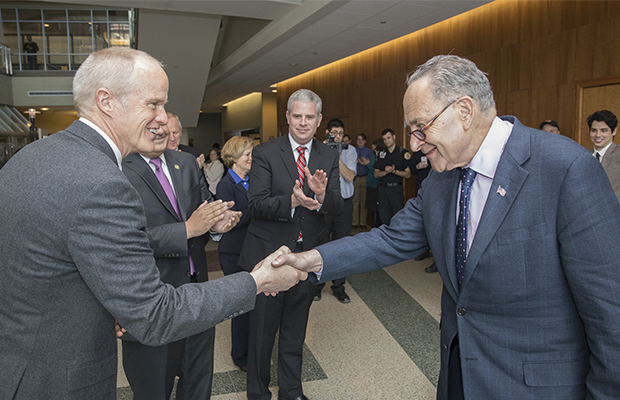
Senate Minority Leader Chuck Schumer visited the University Downtown Center (UDC) Thursday to announce that Binghamton University has received $2.1 million in Federal Emergency Management Agency (FEMA) funds as reimbursement for repairs for damages that resulted from the historic floods of 2011.
Six years ago, the bottom floors of the UDC incurred heavy damage due to Tropical Storm Lee, which devastated much of the Binghamton area. The building was shut down for an entire year and much of the equipment and furnishings inside had to be removed or replaced.
At the time, Binghamton University reached out to FEMA to secure disaster relief funds. FEMA initially sent $3.1 million to help with the cost of repairs.
But, due to what Schumer described as an error, FEMA ended up deducting $2,778,462 from the federal funding award because it believed that BU would be compensated by insurance companies for the damages.
Schumer said that this deduction was errant because the University never received any insurance payout, as FEMA claimed.
“This goes into the Washington category of ‘duh’ — they’re self-insured,” Schumer said, referring to BU. “They don’t have insurance. So FEMA left the University in the lurch.”
Schumer said that FEMA had just now admitted its error and agreed to compensate BU for $2.1 million of what they initially deducted. He said that although some of the money remains uncollected, around 75 percent has already been transferred to the University.
“There’s about $700,000 left,” Schumer said. “But we’ll continue to fight for the remaining money,”
BU originally had to reallocate money out of its own pocket — from what Stenger referred to appropriately as the “rainy day fund” — to pay for the repairs.
“The found money is great to have, and what better use of found money than to do what the original purpose of this college was, and that is to engage our community,” Stenger said.
Stenger specified two major projects that the “found money” will benefit.
Nuthatch Hollow is an 80-acre property that was donated to BU by local businessman Robert Schumann, which will be one of the world’s first “living buildings.” Some of the funds will go toward building a community center on the property, which will be available for use by local residents as well as the University.
Additionally, Stenger hinted at a new endeavor to build a welcome center near the front of campus that will serve community engagement and admissions functions, and provide an outward facing entranceway into the University.
“People will be able to feel welcome, take a little break, park their car, get a small cup of coffee before they venture onto the campus for perhaps an admissions tour, or an event at the Events Center, or perhaps recruiting some of our students at the career placement center,” Stenger said.
At the event, Schumer was accompanied by College of Community and Public Affairs (CCPA) Dean Laura Bronstein, Binghamton Mayor Rich David, Broome County Executive Jason Garnar and Stenger. Each lauded the senator for his dedication to the city of Binghamton and BU.
Schumer is beginning his fourth term in the U.S. Senate and earlier this year replaced former Sen. Harry Reid as the minority leader. He is known to make appearances at BU on Parade Day and in May for graduation and, according to Stenger, is a powerful ally for the school.
“All of us at Binghamton are honored that despite his busy schedule and the many important issues he has to address, he considers us a priority, and we are humbled by his support through the years,” Stenger said.
Schumer returned the compliment and emphasized Stenger’s role in improving the University’s influence on the Southern Tier’s economy.
“If you asked most people, ‘What is the brightest spot on the horizon for the economic future of the Southern Tier,’ they would say Binghamton University, and it is in good part due to this man’s vision,” Schumer said, referring to Stenger.
Bronstein emphasized the importance of the UDC as a beacon in the community that is more than just a building to CCPA.
“This building is more than a building to us, it’s really a symbol of our college’s commitment to the community,” Bronstein said.


